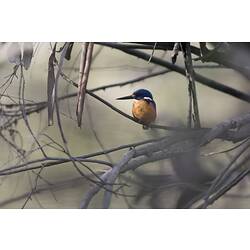General Description
A royal blue head, neck, flanks and upperparts with a violet sheen. The throat is pale orange and underparts are reddish-orange. They have a distinctive orange stripe down each side of the neck and an orange spot in front of the eyes. They have a long pointed bill, red legs and feet and a short blue tail. The bill to tail length is up to 19 cm.
Biology
Azure Kingfishers are never far from the water. Their diet includes aquatic insects, fish, crustaceans and occasionally frogs. They hunt by diving into water from overhanging perches. They frequently perch above foraging platypuses and catch any prey that is disturbed. Captured prey is brought back to their perch where it is hit against the perch before being swallowed head first. Azure Kingfishers are monogamous and both parents incubate the eggs and feed the young. They dig a burrow up to 1 m long in a riverbank, laying five to seven eggs in the end chamber. Breeding territories are defended by breeding pairs. They can be difficult to see as they dart quickly across the water.
Distribution
Indonesia and New Guinea. Northern and eastern mainland Australia and Tasmania.
Habitat
Rivers, lakes, rainforests, swamps, mangroves, estuaries and urban areas.
More Information
-
Animal Type
-
Animal SubType
-
Brief Id
A small kingfisher with a bright blue back and tail, orange-red underparts and orange neck stripes.
-
Colours
Blue, Yellow, White
-
Maximum Size
19 cm
-
Habitats
-
Diet
Carnivore
-
Diet Categories
Fish, Crustaceans, Inverts
-
Endemicity
-
Conservation Statuses
CITES: Not listed, FFG Threatened List: Not listed, EPBC Act 1999: Not listed, IUCN Red List: Least Concern
-
Taxon Name
-
Scientific Author
Latham, 1801
-
Common Name
Azure Kingfisher
-
Kingdom
-
Phylum
-
Subphylum
-
Class
-
Order
-
Family
-
Genus
-
Species Name
azurea







